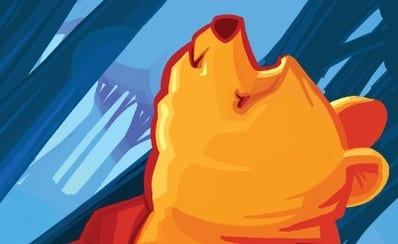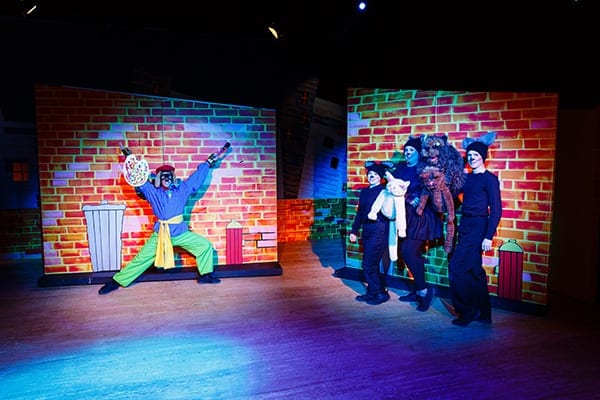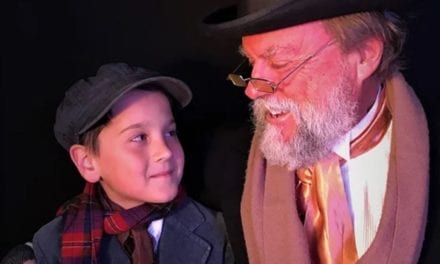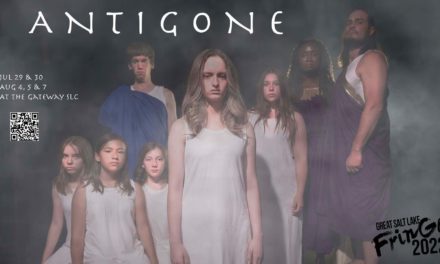SOUTH SALT LAKE — A. A. Milne’s classic book Winnie-the-Pooh has thrived for generations since its publication in 1926—not just because the writing is skillful and witty, but because in his book he captures the very essence of childhood imaginings, the magic of endless possibilities, and the joy found in all that is silly. Matthew Windham’s adaption of Winnie the Pooh, which he also directs at Utah Children’s Theatre, channels that essence of youth with energy and vitality on the stage.
To be clear, Winnie the Pooh at Utah Children’s Theatre is not Disney’s version of Winnie the Pooh. Children won’t be finding the recognizable trademarked characters in the show, but this should not disappoint. In fact, this production should awaken children to the possibilities of interpretation, and they should have no trouble repositioning their expectations of the story and accepting the characters for what they are: the imagined friends of Christopher Robin. Their whimsical costumes designed by Jessica Wilson support this meta-theatrical play. From the first moments the characters appear on stage, their costumes are a pleasant surprise—a not to playing “dress-up.” The ears of every animal are connected to a hat or a headband, the feet of most are oversized, fuzzy animal slippers, and their dress is suggestive of their characters. This is not to say that the costumes are thrown together. They are skillfully constructed, and Wilson has paid exceptional attention to detail. The colors and textures are at once playful and suggestive of the story. That said, children could look at the costumes and be easily inspired to use what they have at home to make their own, and if Utah Children’s Theatre seeks to inspire a love and understanding of art, in the area of costume-design, they succeed in this play.
Once audiences accept the characters visually, they are able to immerse themselves in the imaginary world on stage made all the more vivid by skillful and energetic acting. The familiar characters of Pooh-Bear, Piglet, Owl, Rabbit, Kanga, Roo, Eyore, and Tigger tromp through 100 Acre Woods bringing to life Milne’s stories. Gloomy Eyore is given a birthday party at which he is given rather dreadful presents (including a popped balloon and an empty honey pot). Pooh tries to get some honey by pretending to be a black rain cloud floating to the sky via a balloon. Rabbit, incensed at Tigger’s bouncing, tries to lose him in the forest, only to become lost himself. And Pooh and Christopher Robin save Piglet from a flood by using an upside-down umbrella as a boat. These stories are woven simply together, helped at times by the Narrator, and one is never too long to lose the interest of the young audience. Windham’s direction, too, helps the play move briskly, with the dynamic cast of characters ever-moving on and off the stage.
 Success is also found, more importantly, in the performances. The actor first to appear is Zachery Western, who plays a delightfully “simple” Pooh full of has much fluff as he has brain. Piglet, played with admirable physicalization by Jessica Wilson, is also charming and child-like (and the most beloved character of the night by my three-year-old boy). Meighan Smith’s Rabbit is perfectly impatient and self-important, just as Amanda Smith’s Kanga is sweetly motherly, and Christopher Taylor’s Owl is exhaustingly verbose. Bryson Dumas gives a laugh-out-loud performance as Eeyore, full of gloom and self-deprecation, but director’s Matthew Windham performance as Tigger stands out. His unbridled, bouncing energy on stage is magnetic and undeniably child-like, shown at its best when he interacts with Roo, played by child actor Belle Warren, who pulls out all the stops for her character. The teamwork and timing of Tigger and Roo is delightful in the play, as it is when Eeeyore and a new character called “Hedgie,” played by child actor Mila Howells, interact. Though not found in the book, the addition of Hedgie in the play and “Little Owl,” another added character played by child actor Themi Kamouris are welcome additions on stage, bringing more youthfulness to this production for young audiences. Of course, the character of Christopher Robin does this as well, and Bronx Warren’s performance of the 100 Acre Wood hero is all sweet innocence.
Success is also found, more importantly, in the performances. The actor first to appear is Zachery Western, who plays a delightfully “simple” Pooh full of has much fluff as he has brain. Piglet, played with admirable physicalization by Jessica Wilson, is also charming and child-like (and the most beloved character of the night by my three-year-old boy). Meighan Smith’s Rabbit is perfectly impatient and self-important, just as Amanda Smith’s Kanga is sweetly motherly, and Christopher Taylor’s Owl is exhaustingly verbose. Bryson Dumas gives a laugh-out-loud performance as Eeyore, full of gloom and self-deprecation, but director’s Matthew Windham performance as Tigger stands out. His unbridled, bouncing energy on stage is magnetic and undeniably child-like, shown at its best when he interacts with Roo, played by child actor Belle Warren, who pulls out all the stops for her character. The teamwork and timing of Tigger and Roo is delightful in the play, as it is when Eeeyore and a new character called “Hedgie,” played by child actor Mila Howells, interact. Though not found in the book, the addition of Hedgie in the play and “Little Owl,” another added character played by child actor Themi Kamouris are welcome additions on stage, bringing more youthfulness to this production for young audiences. Of course, the character of Christopher Robin does this as well, and Bronx Warren’s performance of the 100 Acre Wood hero is all sweet innocence.
Utah Children’s Theatre’s production of Winnie the Pooh is the perfect medium to introduce children to live theatre, the kind of theatre that encourages the use of their imagination instead of bombarding their senses with over-the-top special effects, such as those found in the expensive Broadway tours (although those shows certainly serve their purpose and delight). Even the set, designed by James Parker, is somewhat of a blank canvas, all black and white with a single large tree “drawn” up in the center that marks a variety of locales. The whole production, of course, makes one want to head straight to the library to find a copy of Winnie-the-Pooh or The House at Pooh Corner, and if attending the theatre makes children (and adults) want to read more, all the better.
If you have never taken your children to the theatre or have never tried a Utah Children’s Theatre production, this would be a good opportunity. This was my first experience there with two kids in tow, no less, and I was delighted and relieved to find the theatre so accommodating from parking and seating to restrooms and snacks. I was told that it was recently remodeled, and I was impressed. It felt like a truly lovely night out, one that we are all excited to repeat!






